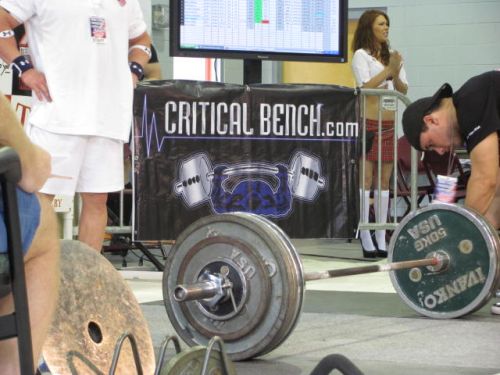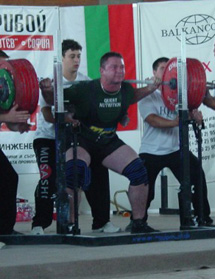Passage from Chapter 2 of the RTS Manual
by Mike Tuchscherer

I decided to post Chapter 2 of the RTS Manual so you can 1) get an idea of my writing style, 2) get a solid understanding of some of the fundamental concepts of RTS, and 3) so you can see what you're missing if you haven't read the RTS Manual! Enjoy!
The RTS Manual
Chapter 2 - Rates of Perceived Exertion (RPEs)
This chapter concerns the RPE system in Reactive Training. Pay attention, because if you don't get this right, the entire system can be thrown off to a degree. I would say that this information is absolutely central in making the program effective as you advance to higher stages.
RPE stands for Rate of Perceived Exertion. Basically, it's how hard something feels to you at the time. It is a subjective measure of your strength at a given time. We rate this on a scale from 1 to 10. The higher the number, the harder the set felt. You can develop your own, or use the one that we will discuss in this chapter. The main thing is that you are consistent.
Let's start with why you should use an RPE scale as opposed to a percentage program. Even though percentage programs are easy to use, they are very limited in how accurate they can be. There are many things that throw off your percentages. The longer you go in a training cycle, the less accurate they become, due to your own individual strength adaptation. Each athlete is different, because of differences in training history, fast-to-slow-twitch ratio, whether you've been sick or not, your "bad" days and "good" days, and general sleep patterns. Basically, life happens and you won't always be 100% when you come in to train.
An RPE overcomes this stuff by allowing you to regulate training based on how hard a weight feels (which is all a percentage tries to do anyway). By using an RPE, you can regulate training more effectively, and do so in a way that would automatically take into account all of the individual differences mentioned above.
Now, if you're curious as to what RPEs are, here is the scale that we use:
10- Maximal. No reps left in the tank.
9- Last rep is tough, but still 1 rep left in the tank.
8- Weight is too heavy to maintain fast bar speed, but is not a struggle. 2-4 reps left.
7- Weight moves quickly when maximal force is applied to the weight. "Speed weight"
6- Light speed work. Moves quickly with moderate force.
5- Most warm-up weights
4- Recovery. Usually 20+ rep sets. Not hard, but intended to flush the muscle.

RPEs below 4 are not important.
Here's how it works. You apply it to a set-rep range. For example, if you were going to do 5x5 at an 8-9 RPE, then you know you're doing 5x5 with a weight that is between an 8 RPE and a 9 RPE. So you should select a weight that will allow you to do between 1 and 4 more reps than the set requires.
If the RPE system seems awkward at first, don't worry, you'll get used to it and be able to use it quickly. An easy way to gauge the RPE of a set is to ask yourself how many more reps you could've done with a particular weight. Here is where honesty is the absolute key! If you're too macho and say, "yeah, I coulda done one more" when you know that the set was maximal, your training will be thrown off. This tends to be tough for the training hot-heads that always want to go heavy, but also for the timid who are afraid to push themselves. You must be disciplined to use this method effectively!
There is also a chart that I developed that roughly correlates an RPE and rep range to a percentage. It should only be used as a guide, not to attempt to derive a max. I'll insert the chart, then go through how to use it.

As you can see, for each rep range and the correlating RPE, there is a percentage. 80% is where peak force is produced. Be careful with how much time you spend in the 90%+ area. The closer you are to the upper right corner, the more accurate the chart is.
Here's how to use it. In the above example, you can see that we did 5x5 at 8-9 RPE. Using the chart, this roughly correlates to 70-75%. The next time, you may want to pick a protocol that allows you to train in the 80-85% range or even the 90%+ range. The choice is up to you and how you want to program your training, but this tool can help you approximate how heavy you have been going in terms of percentage.
So, using this knowledge, here is what happens to your protocols:
Volume
(sets x reps)
- 6x3 @8-9
- 6x2 @8-9
- Speed work ups:
- 8x2 @6-7
- then work up to 1x2 @8-9
- 5x5 @9-10
- 6x4 @8-9
Intensity
- 1 to 3 Rep Max
- 3x3 @9-10
- 4x2 @9-10
- 4 to 5x1 @9-10
Just to reiterate, RPEs allow you to regulate your training intensity based on your condition right now. Not your last meet, not yesterday, not even last set. It allows you to quantify where your preparedness is at any given time. This is an extremely powerful tool, and one that will be invaluable in the Reactive Training System.
Mike Tuchscherer is the owner of Reactive Training Systems, a company dedicated to individualized physical training. The goal of RTS is to help you become a dominant force in your sport! Learn more by visiting www.ReactiveTrainingSystems.com.
Mike himself is an accomplished Powerlifter. He has over 12 years of experience training and researching the best training methods in the world. Mike has competed in raw and single ply competitions. He recently won the Gold medal representing the USA at the 2009 World Games; becoming the first American male to ever win this distinction. His best lifts in IPF competition are a 903 squat, a 644 bench press, an 826 deadlift, and a 2342 total in the 275 pound weight class.
More Articles By Mike Tuchscherer
Return to the Workout Articles Archive
|